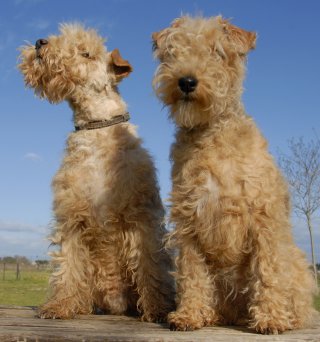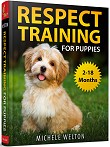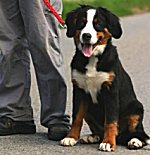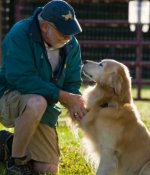Lakeland Terriers: What's Good About 'Em, What's Bad About 'Em
Lakeland Terrier temperament, personality, training, behavior, pros and cons, advice, and information, by Michele Welton, Dog Trainer, Behavioral Consultant, Author of 15 Dog Books

The AKC Standard describes the Lakeland Terrier as "bold, gay and friendly, with a confident, cock-of-the-walk attitude."
Though not as boisterous or argumentative as some terriers, the workmanlike Lakeland is still animated and intense.
Always alert and ready to go, he has strong working instincts and loves to exercise outdoors. Unfortunately, his curiosity and tenacity can get him into tight spots (literally) unless your fences are secure and he is well supervised.
The Lakeland Terrier does best with active owners who are confident and consistent, for he has a marked independent streak and will take advantage if indulged.
Lakelands are better with other dogs than some other terriers. But they won't back down if challenged. Little creatures that run, including your child's pet hamster, will quickly come to an untimely end.
When well socialized, the Lakeland Terrier is polite with strangers. Yet he can be counted on to sound the alert when anything is amiss. As with most terriers, excessive barking may need to be controlled.
Lakeland Terriers love to tunnel and dig and can be possessive of their food and toys.
If you want a dog who...
- Is small, yet dynamic, sturdy, and tough, not a delicate lapdog
- Makes a keen watchdog
- Doesn't shed too much
A Lakeland Terrier may be right for you.
If you don't want to deal with...
- The dynamic terrier temperament (see full description below)
- Providing enough exercise and activities to keep them busy
- Aggression toward other animals – chasing instincts
- Stubbornness
- Digging holes
- Barking
- Regular brushing and clipping
A Lakeland Terrier may not be right for you.
 |
Dog Breed Traits – Which Traits Are Right For You? In this brand new series, I'll help you decide which dog breed traits would best suit you and your family, your home and yard, and your lifestyle, so you can choose the best dog breed for your family. |
Keep in mind that the inheritance of temperament is less predictable than the inheritance of physical traits such as size or shedding. Temperament and behavior are also shaped by raising and training.
FREE eBooks by Michele Welton
![]() "Respect Training for Puppies" and "Teach Your Dog 100 English Words" are free step by step guides to teaching your pup to be calm and well-behaved.
"Respect Training for Puppies" and "Teach Your Dog 100 English Words" are free step by step guides to teaching your pup to be calm and well-behaved.
![]() "11 Things You Must Do Right To Keep Your Dog Healthy and Happy" is a free guide to keeping your dog mentally, physically, and emotionally happy and healthy so you can enjoy a longer lifetime of companionship.
"11 Things You Must Do Right To Keep Your Dog Healthy and Happy" is a free guide to keeping your dog mentally, physically, and emotionally happy and healthy so you can enjoy a longer lifetime of companionship.

More traits and characteristics of the Lakeland Terrier
If I was considering a Lakeland Terrier, I would be most concerned about...
- The dynamic terrier temperament. Most terrier breeds are remarkably similar. The same words are used over and over – quick to bark, quick to chase, lively, bossy, feisty, scrappy, clever, independent, stubborn, persistent, impulsive, intense.
- Providing enough exercise and mental stimulation. Lakeland Terriers are active go-getters who require regular opportunities to vent their energy and romp about in a safely enclosed area. Terriers should not be trusted off-leash. They will take off, oblivious to your frantic shouts, after anything that runs.
- Barking. Terriers are often too quick to sound the alarm at every new sight and sound. You have to be equally quick to stop them.
- Animal aggression. Lakeland Terriers are a determined force to reckon with if they decide to initiate or accept a challenge to fight. Most terriers have strong instincts to chase and seize small fleeing creatures. This can make for conflict if you own a cat. It may be much worse than that if you own a pet rabbit or hamster.
- Mind of their own. Like all terriers, Lakelands must be taught at an early age that they are not the rulers of the world. The toughness that makes them suited to killing vermin can frustrate you when you try to teach them anything. Terriers can be stubborn and dominant (they want to be the boss). You must show them, through absolute consistency, that you mean what you say. To teach your Lakeland to listen to you, "Respect Training" is mandatory. Follow my free online training programs.
- Potential defensive reactions. If you need to physically chastise a terrier, and you go beyond what THEY believe is a fair correction, terriers (as a group) are more likely than other breeds to growl or snap. As an obedience instructor, I'm always extra careful when putting my hands on a terrier for a correction.
I do not recommend terriers for small children. Many terriers will not tolerate any nonsense from little life forms whom they consider to be below themselves in importance. Many terriers are quick to react to teasing, and even to the normal clumsiness that comes with small children (accidental squeezing of their ears or pulling of whiskers or stepping on their paw). Many terriers are possessive of their food and toys and will defend these from all comers, including children.
- Grooming. Lakeland Terriers require clipping and trimming every few months. Breed purists may say that terrier coats should never be clipped because it makes the coat softer and more prone to matting. Instead they advocate hand-stripping (each dead hair pulled out so a new one can grow in its place). But in my opinion, stripping is too time-consuming and uncomfortable for the dog. Many groomers won't do it anymore. For pet dogs, I think clipping is just fine.
My best-selling books – now available FREE on my website
 Respect Training For Puppies: 30 seconds to a calm, polite, well-behaved puppy is for puppies 2 to 18 months old. Your puppy will learn the 21 skills that all family dogs need to know. Click here to read for free.
Respect Training For Puppies: 30 seconds to a calm, polite, well-behaved puppy is for puppies 2 to 18 months old. Your puppy will learn the 21 skills that all family dogs need to know. Click here to read for free. Teach Your Dog 100 English Words is a unique Vocabulary and Respect Training Program that will teach your adult dog to listen to you and do what you say. Click here to read for free.
Teach Your Dog 100 English Words is a unique Vocabulary and Respect Training Program that will teach your adult dog to listen to you and do what you say. Click here to read for free. 11 Things You Must Do Right To Keep Your Dog Healthy and Happy helps your dog live a longer, healthier life. Get my honest advice about all 11 Things before you bring home your new puppy, because some mistakes with early health care cannot be undone. Click here to read for free.
11 Things You Must Do Right To Keep Your Dog Healthy and Happy helps your dog live a longer, healthier life. Get my honest advice about all 11 Things before you bring home your new puppy, because some mistakes with early health care cannot be undone. Click here to read for free.Related posts you might enjoy






